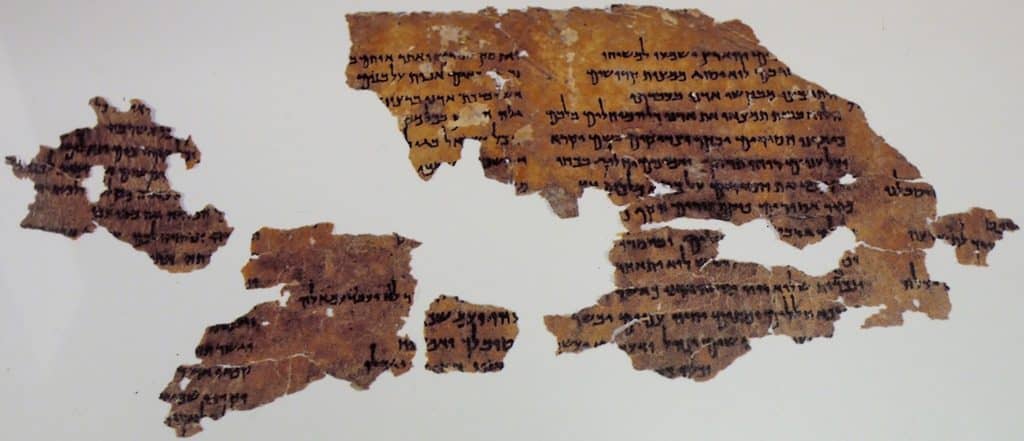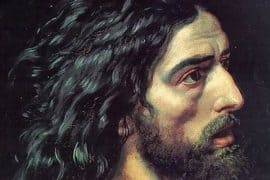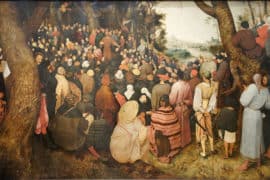In this new six part series I present responses to essays offered in my course at UNC Charlotte on “John the Baptist.” John is the most underrated figure in Christian tradition, rarely given his due as a messiah and inaugurator of the movement Jesus himself arose from. The responses are by my former student, Jeff Poplin, now a USAF Lt Colonel and fighter pilot, graduated with honors from the Air Force Academy. Jeff wrote them without notes in response to exams given in the course! They offer a good, concise, and rather extraordinary summary of what we covered in the course:
Topic: In the 1st centuries BCE Messianic expectations among various forms of Palestinian Judaism were apparently widespread and complex. Both the John the Baptizer movement and the Jesus movement develop out of these contexts. Other than the New Testament materials, our best textual evidence of the ways in which such apocalyptic groups were casting their messianic hopes and dreams is found in the Dead Sea Scrolls and related apocalyptic literature. Using Qumran as your main example, what composite picture emerges of the ways in which such groups appropriated the Messianic materials of the Hebrew Bible (as covered in question 1 above)?
The Qumran group has been emphasized as a breakaway movement of priests from the Essenes. They moved to the desert and set up a community along the shores of the Dead Sea, possibly following the doctrine of separation and preparing the way in the wilderness philosophy set forward in Isaiah 40:3 and Malachi 3:1. Fortunately, scholars have been able to recover some writings of this community dubbed “The Dead Sea Scrolls.” One important piece of this puzzle of their views on apocalypticism and messianic material is the Community Rule (1QS). Column VIII instructs its members to separate from ungodly men and go into the wilderness to prepare the way of Him. Column IX states, “this is the time for the preparation of the way in the wilderness.” Both these phrases reflect the groups awaiting of a coming messiah and following the words of Malachi 3:1 and Isaiah 40:3. Most interesting is Column IX of the Community Rule. It read, “…there shall come the Prophet and the Messiahs of Aaron and Israel.” Presented here is an idea of three figures (similar to Exodus17, I Samuel, and Zechariah 4, 6). Here the Prophet is unmistakably the “prophet like Moses” figure in Deuteronomy 18:15-18. Messiahs in this context is plural and it specifically states two of them (of Aaron and Israel). This reverts back to the notion of a priestly messiah (Exodus 40:13) representing Aaron on one side of the Adon and of a kingly messiah (I Samuel 10) representing Israel/Judah/David on the other.

The Damascus Document is another valuable document allowing scholars to analyze and interpret the Qumran ideologies. From this text, unlike the Community Rule where one had not shown up yet, it appears the group came to believe they experienced the Adon/Prophet like Moses but not the two messiah’s. He is referred to as the Teacher of Righteousness as seen in Column VI of version A “until he comes who shall teach righteousness.” Column VII again visits the groups mentality of there being two messiah’s. It makes reference to the star (interpreter of the Torah) as the priestly messiah, coming from Damascus (Isaiah 9:1-2) and the scepter as a kingly messiah figure. This wording would suggest they were studying Numbers 24:17 and picked up the language of star and scepter. Version B of the Damascus Document is thought to come later as it mentions in Column VIII the “gathering in” or death of the Teacher of the community. The Testaments of the Twelve Patriarchs are documents also found in the Qumran material. They are said to be, although seriously doubted by scholars, the last words of Simeon and Dan. This Qumran two messiah tradition is visible in Column VII when it speaks of Israel submitting to Levi and through Judah (priest and king) because it is from them salvation will come. Plural messiahs are implied here. One of the most fascinating finds was a copy of Malachi from Qumran that differs from modern day texts. In chapter 3, the text is talking of God sending a messenger to prepare the way and in verse 2 states, “but who can endure them, they come.” Present day texts state “who can endure the day of his coming.” Here we have a first century BCE text not affected by time or translation, showing a plural messiah tradition. What can be said of the Qumran group at this point? They appropriated messianic materials of the Hebrew Bible in such a way as to transform their way of life. First by moving to the desert and preparing the way Isaiah 40:3 for the coming messiahs. Relying on Exodus, and Zechariah, they formed ideas of the three figures: Adon, Priest (Aaron), and King (Israel) and wrote about them in community documents while awaiting their arrival. With the arrival of the teacher (died in 50 BCE), they thought this was it, but sadly, given their hopes and expectations, they saw no messiah’s. However, after the teacher’s death, hope stayed alive for another century or so until the group finally disappeared without their prophecies or hopes coming true.









Comments are closed.